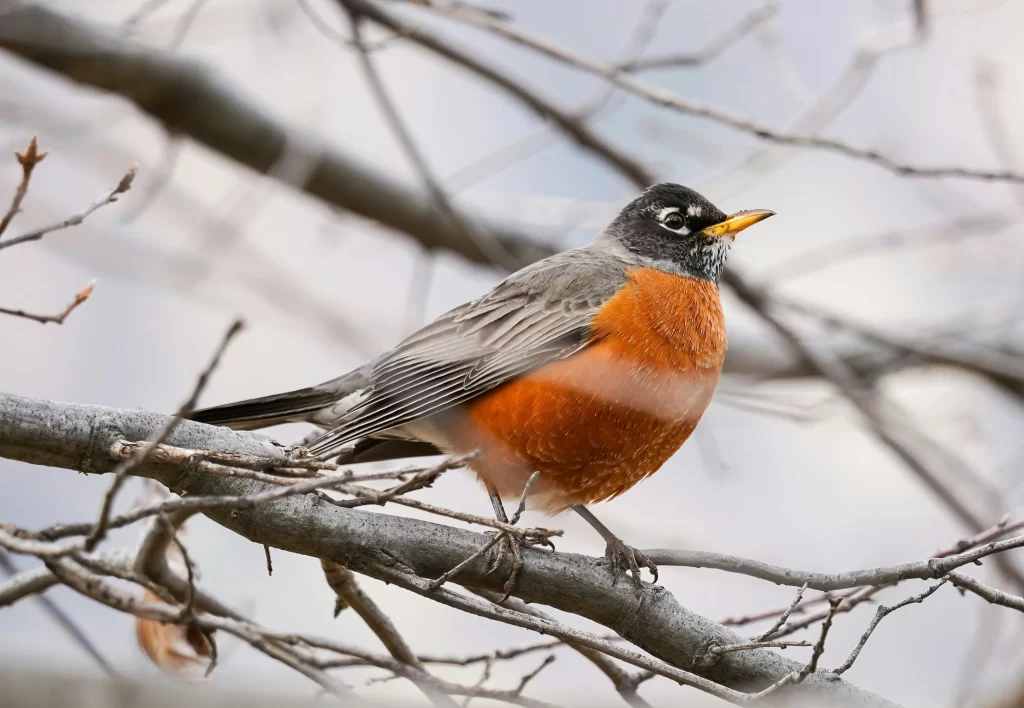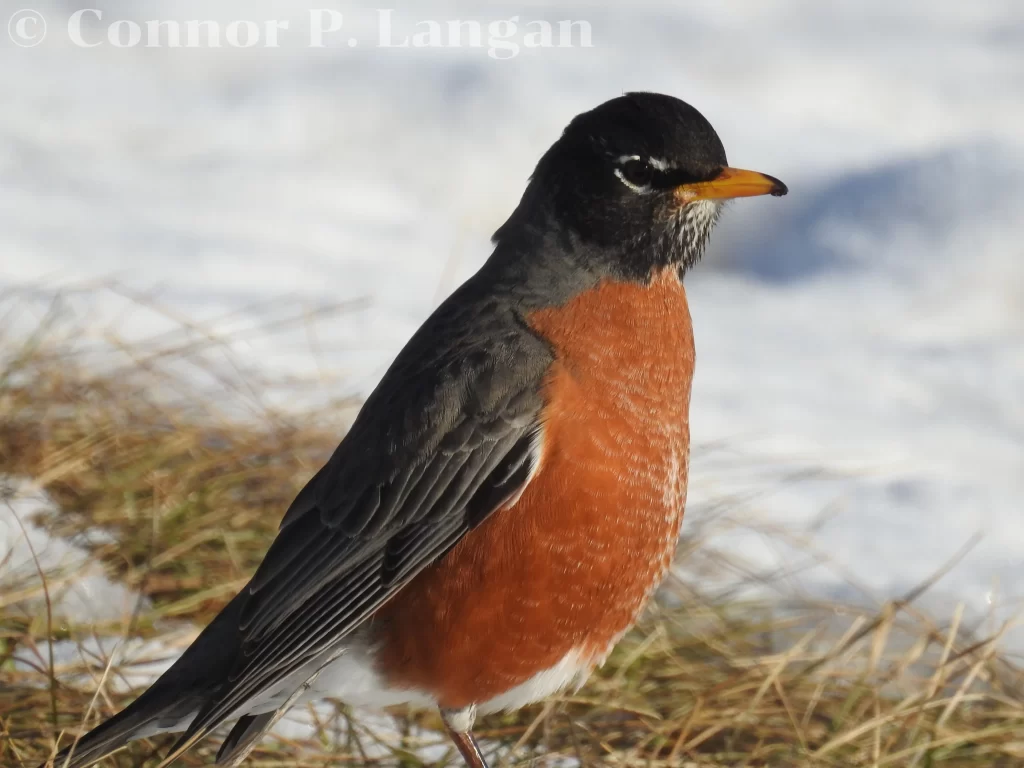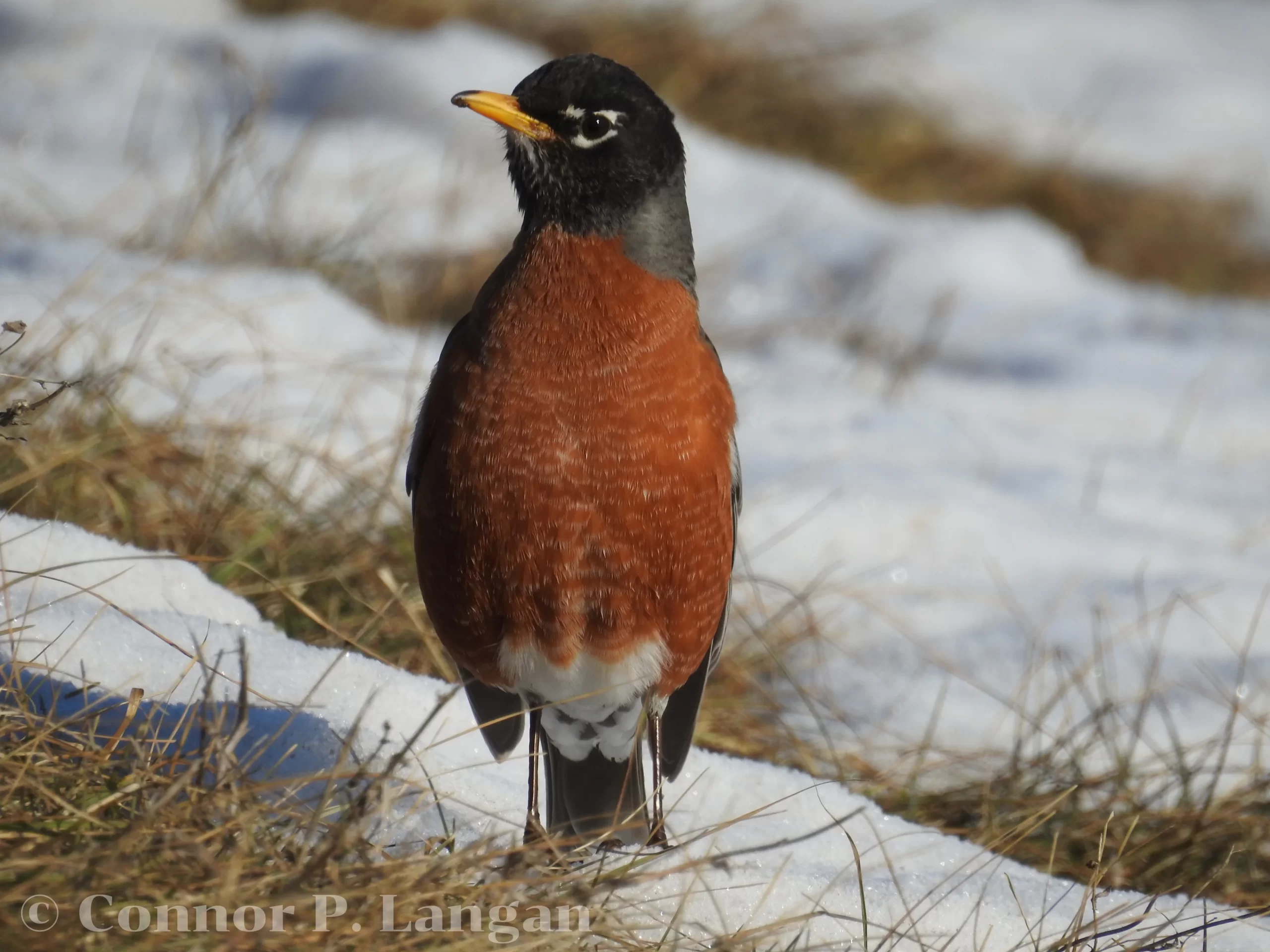American Robins are easily recognizable across North America. They are famed for their supposed tendencies to fly south for the winter. Although many robins do—indeed–fly south before winter, many stay put in frigid places like the Upper Midwest and Canada. So, what do robins eat in the winter when they remain in locations with cold winters?
Well, this article will answer that question and many more that pertain to robins in winter. Whether you’re interested in feeding robins in winter or are simply curious about how these birds survive, this article has you covered! Keep reading to discover what robins eat during difficult times and what to feed robins in winter.
Table of Contents
What Do Robins Eat In The Winter?
After the breeding season is over, robins promptly begin to start fattening up for the winter. Nevertheless, winter in North America can be a trying time for many birds. Indeed, a snow-covered landscape and frigid temperatures mean that robins cannot eat earthworms like they do during warmer months. So, what do robins eat in the winter to survive this season?
A robin’s winter diet will depend on where a bird spends its winter. Those in snowy areas will eat berries and seeds since insects won’t be available. If a robin winters in an area that is warm enough for insects, these birds will happily eat these creatures.
Okay, this explains what robins eat in winter under normal circumstances, but surely their diets must change in brutally cold places like Canada. What do robins eat in the winter in Canada?

What Do Robins Eat In Winter In Canada
Canada is not the most hospitable place for robins in the winter, as this country can get quite chilly and receive a plethora of snow. Nonetheless, robins are tougher birds than many give them credit for, and they are often up to the challenge of overwintering here. So, what do robins eat in winter in Canada?
Well, much like their bluebird cousins that overwinter in Canada, American Robins sustain themselves on diets that are mostly centered around berries. Alright, great – but what fruit do robins eat? The fruits of chokecherries, junipers (cedars), and crabapples are important foods for robins attempt to overwinter in Canada.
Those interested in providing food for robins in winter or potentially hosting these songbirds can plant any of these trees to provide a natural source of food. However, if you’re inclined to offer fruit to robins in your backyard, try providing small pieces of apples or raisins.
Where Do Robins Go In The Winter?
American Robins are synonymous with the act of flying south for the winter. We know that some robins certainly participate in southbound migration before winter, but some robins linger in northern locales near their breeding areas. Where do robins go in the winter if they spend their winters up north?
Well, robins wintering in Canada, Alaska, or the upper tier of states in the Lower 48 won’t be caught in open areas where they are commonly observed during summer. Indeed, such conditions would be too cold for robins despite their warm-blooded physiology.
Instead, robins congregate in flocks and head to areas that are both sheltered from the elements and abundant in their food offerings. This means that robins are not often found in backyards, but this does not mean that they have left the area entirely.
How Do Robins Survive The Winter?
Robins that spend the nonbreeding season in locations with mild temperatures do not need to worry about succumbing to the elements. However, how do robins that live in places that receive snow survive the cold temperatures?
Here are some adaptations that allow these songbirds to survive the winter:

Fat Reserves
Prior to the winter season, robins may try to fatten up by consuming copious amounts of food. Eating lots of food promotes a layer of fat that can help them survive the winter.
Not only does this layer of fat keep robins warm, but it also provides these birds with much-needed energy reserves in the winter. During times in which foods are scarce, robins can rely on their fat reserves to supply themselves with energy.
Insulating Feathers
Some birds may grow additional feathers in winter. Feathers have several purposes like fat, as they help to shield robins from the elements and insulate their bodies.
Body heat generated is then maintained–in part–because of feathers. Birds without a thick layer of feathers would struggle to maintain their body heat.
Staying Out Of The Elements
Perhaps the simplest thing that a robin can do to stay warm during the winter would be to remain in sheltered locations.
Places like coniferous trees, dense thickets, and ravines are great places for these birds to seek refuge from the wind and snow. The benefits of keeping a low profile in the winter are many. Not only does this behavior keep robins warm, but it also protects them from predators.
What To Feed Robins In Winter
If you enjoy feeding birds in your backyard, you may ask, “How do you know what to feed robins in winter?”
Backyard birders will be thrilled to hear that feeding robins in winter is the best time to feed these birds.
So, what do robins like to eat in the winter? Well, putting out a mixture of cracked corn, millet, and milo will attract little other than House Sparrows. Instead, good food for robins in winter includes dried berries, suet, and mealworms for American Robins if you want to attract them to a bird feeder in winter.
Homeowners can also lure these songbirds to their yards during the winter if they have trees that produce fruit. Fruits like crabapples, cherries, and dogwood are critically important to wintering robins. Feeding robins in winter with fruiting trees is a great way to ensure that they’ll stick around all year.

Looking For American Robins In Winter
Remember, you have to find a robin’s food sources before you can locate robins in winter. So, what do American Robins eat in winter?
Well, winter is a prime time for robins to gorge themselves on fruits and berries that remain from the previous growing season.
Here are some good places to search for American Robins if you live in areas that routinely get snow:
- Areas with large concentrations of fruit trees
- Cedar (juniper) tree thickets
- Cemeteries with conifers
- Forested neighborhoods
- Orchards
American Robins will be concentrated in sheltered areas that offer plenty of food. These birds love to feed on cedar berries and crabapple berries this time of year.
Those who keep their eyes out for robins during the winter may be surprised to find that these birds stay in their area year-round.
What Do Robins Eat In The Winter Fast Facts
Q: What do American Robins eat?
A: American Robins are omnivorous, eating insects, berries, and seeds.
Q: What do robins eat in the winter?
A: Robins eat berries, seeds, and insects–if available–during winter.
Q: What fruit do robins eat?
A: American Robins eat an assortment of native fruits like juniper fruits, crabapples, and chokecherries.
Q: What can I feed robins in the winter?
A: Those interested in feeding robins in winter can set out dried mealworms.
Q: Where do robins go in the winter?
A: American Robins may migrate south of their breeding range to warmer locales, but they may also stay in the same place for the whole year.

